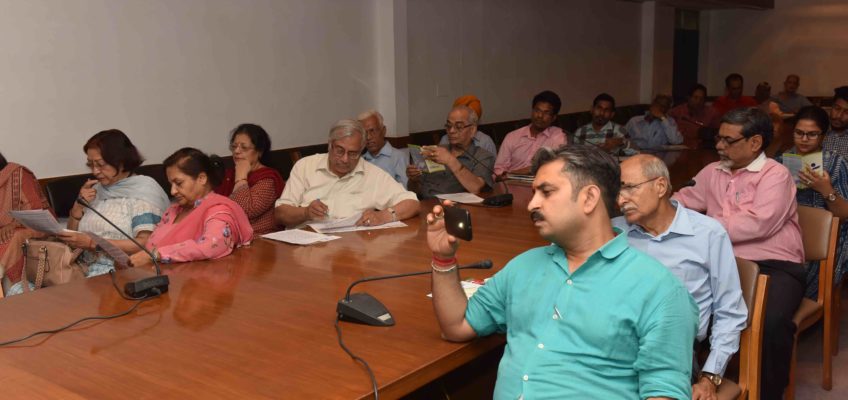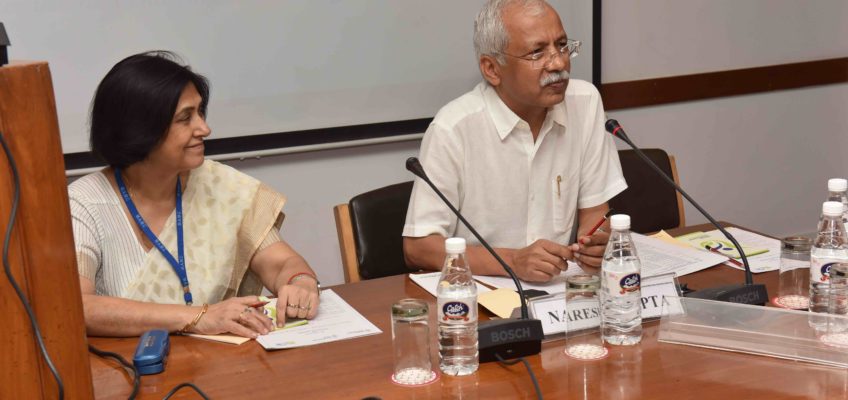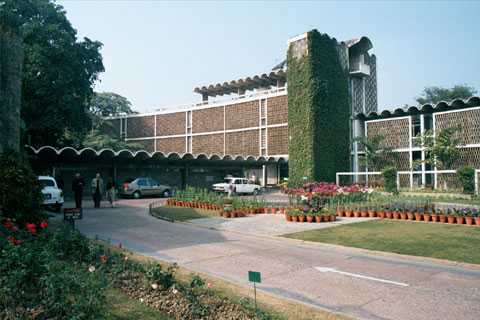IIC- HEC series on ‘Environment and Health’
WATER, WATER TO DRINK… WHAT CAN GO WRONG?
at IIC, New Delhi under the aegis of
Health Environment Foundation & India International Centre, New Delhi
The 15th April 2017 Panel discussion under the Health Environment Foundation (HEF) and India International Centre (IIC) initiative on Environment and Health Series was focused on Water, water to drink… What can go wrong? moderated by Dr. Naresh Gupta, Director-Professor, Maulana Azad Medical College, New Delhi and President, Health Environment Foundation. The other panelists included Director-Professor Suneela Garg, Department of Community Medicine, MAMC, New Delhi; and Dr. Vivek Dixit, Research Scientist- II, AIIMS, New Delhi. Shri RS Tyagi, Member (WS), Delhi Jal Board could not join the panel.
It emerged that:
DRINKING WATER is utterly important, emergent and emotive subject that affects peaceful survival of mankind on this planet. Even though two-third’s of planet earth is covered with water, only 0.002% is for drinking and fit for human consumption Around 1.2 billion people live in areas of physical scarcity. The Bangladesh Prime Minister is stated to have said “Got power, No water!”
More that half of India faces high to extremely high water stress. India hosts 18% of world’s population but has only 4% of the global water resources. In India, water is a State subject. Its inequitable, erratic and unsustained distribution has many other implications. The State of Delhi generates 700 million gallons per day (MGD) of Waste Water, of which 80% is of domestic origin. Installed Sewerage Treatment Capacity in 35 Plants (STP) is 682 MGD, with utilization factor of about 60%. There are Effluent Treatment Plants (ETP) in 2,000 industrial units. Recycling of the un-utilized wastewater back into water bodies may add to on-going pollution of sound water. In 2015, WHO introduced the concept of Sanitation Safety Plans to support implementation of the wastewater guidelines.
Per capita availability of water in India has gone down from 6,042 cuM to about 1,545 cuM between 1947 and 2011.
Having achieved the Millennium development Goal (MDG 7) on drinking-water, the 2010 UN General Assembly explicitly recognised the human right to water and sanitation, including sufficient, continuous, safe, acceptable, physically accessible and affordable water for personal and domestic use. The Hon’ble Supreme Court of India has ruled in favour of making access to clean drinking water a fundamental right as part of Right to Life in Article 21 of the Indian constitution. However, in response to a question from Hon’ble Member of parliament Smt. Jaya Bachchan, the Union Minister of State for Drinking Water and Sanitation responded on 17 April 2017 “Currently there is no proposal by this Ministry to declare access to safe drinking water as a fundamental right of every citizen.”
- Polluted Water is an important source for microbiological diseases in humans, and could be from direct or indirect spread. Water-borne diseases in India are a major focal point in our nation’s march towards Swacch Bharat Abhiyaan, accounting for the widespread common diarrhoea diseases especially among children, typhoid, cholera, hepatitis, and a number of other faeco-orally transmitted infections. Most are preventable. In addition, the stagnant or the ‘bad water’ water can become a source of mosquitos spreading other microbial diseases like malaria, dengue, chikunguniya etc. During the summer- rainy months, the human-animal face-oral contamination of water increases the incidence on many common transmissible infections. Proper hygiene, hand washing, and waste disposal are paramount for prevention.
- With passage of time, the quality of ground water has undergone changes, making much it less usable- sometimes even hazardous. Inland salinity is a problem in arid/ semi-arid regions of Rajasthan, Gujarat, Haryana, Punjab, and a smaller extent in Delhi NCR, Uttar Pradesh, Madhya Pradesh, Maharashtra and Karnataka. Coastal Salinity is encountered in many areas along the 7,500 Km Indian subcontinent coastline, in Rajasthan, Tamil Nadu, Porbander, Pondicherry and Orissa. Salinity can be reduced with reverse osmosis (RO Systems), ion exchange and electrodialysis.
- Ground Water also faces threat from chemical pollution from inorganic elements like arsenic, fluoride, lead, iron, mercury as also many an organic harmful solvent in the effluents discharged into water bodies.It is reported that groundwater in one-third of the India’s 600 districts may not be fit for drinking as the concentration of fluoride, iron, salinity and arsenic exceeds the tolerance levels.
- Fluoride in high concentrations (beyond 1.5 mg/L) in ground water for drinking is a major health problem in India, and encountered in the districts of Rajasthan, Andhra Pradesh/ Telangana, Orissa, Gujarat, Karnataka, Madhya Pradesh, Haryana, and lesser extent in another half a dozen States including Delhi. Possibly 65 million people suffer from fluorosis, a crippling disease due to high amount of fluoride. The techniques to remove salinity are effective against fluoride contamination too. Activated alumina adsorption is also effective.
- Detection of the presence of another element Arsenic in ground water is more recent. Arsenic compounds have been used in several small and large-scale manufacturing activities. Contamination of ground water from arsenic has serious health impacts on human beings. It is found in several States in India, mainly West Bengal, Bihar, Chhattisgarh, Uttar Pradesh, and Assam. Five million people may be suffering from arsenicosis in West Bengal due to high amount of arsenic. Removal of arsenic from ground water is limited to activated alumina adsorption, and one has to rely on arsenic-free aquifers or alternative sources.
- Many of these sources of pollutants (vide supra) also enter the water besides the soil and the land that also faces the onslaught of pesticides, herbicides, and fungicides from the agriculture runoff. Recognising the dangers of POPs culminated in the Stockholm Convention on Persistent Organic Pollutants with more than 160 countries agreeing to eliminate or reduce the release of POPs into the environment. The Stockholm Convention currently focuses on 21 POPs of immediate concern: pesticides, industrial chemicals, and unintentional byproducts – resulting from combustion and industrial processes and among the most potent cancer-causing chemicals known.
- Contamination of rivers and water bodies from sewage is another major hazard in India, affecting 70-80% of the water supply. A 3-year analysis of water quality in 290 rivers in India by the CPCB, Central Pollution Control Board, reported about 66% of the stretches monitored had high organic pollution. It translates into 8,400 km of these rivers are badly polluted and not fit for supporting aquatic life. “Increasing flow of untreated waste water from cities into these rivers is the reason for our rivers getting polluted,” says Shashi Shekhar, CPCB chairman and special secretary in the Environment Ministry. Imagine a situation where one river GANGA alone which provides water to 500 million people in India and the health risk coming from its contamination!
- Untreated Sewage into water bodies has doubled between 1991- 2008 from 12,000 MLD à 24,000 MLD in Class I and II cities in India
- What is even more disturbing are the findings from the 2016 study published in the International Journal of Engineering Sciences and Research Technology concluding that even the expensive water treatment plants were incapable of treating the polluted water, and that the water was unfit for any purpose. Whereas this water continues to be used for agriculture and other purpose.
- Newer concerns arise from the escape of pharmaceutical drugs into water and soil with deleterious effects on human health and the biodiversity. This reminds me of a great medical teacher Oliver Wendell Holmes, Sr (1809-1894) who said:
“I firmly believe that if the whole materia medica, as now used,
could be sunk to the bottom of the sea, it would be better for mankind-
and all the worse for the fishes”
- Ready availability of safe, preserved quality Drinking Water is important to save the mankind from myriad of water-related health problems. According to WHO report Novemebr 2016, 1.8 billion people use drinking-watt resource contaminated with faeces; and by circa 2025, half of the world’s population will be living in water-stressed areas. Currently, in low and middle-income countries, 38% of healthcare facilities lack improved water source.
The contaminants and pollutants highlighted above from chemicals/ elements like arsenic, fluoride, lead, other heavy metals, nitrates from fertilisers, carcinogenic pesticides (DDT) are detrimental to human health in many ways.
Further, the human health gets gets affected from the microbial onslaught from from ingestion of water contaminated by human or animal excreta. These concurrent water-borne diseases organisms such as cholera, typhoid, amoebic/ shigella dysentery/diarrhoeal disease causing microbes, campylobacter, cryptosporidiosis, giardiasis, and several helminths gain access into human body leading to common and at times deadly diseases. .These are much more frequent in the developing countries. More than five million people die each year from such waters. More than 2 million dies from water-related diarrhoea alone, most small children.
Here a special mention is needed of the bacteria Escherichia coli which is present in large numbers in the intestines of humans and animals where it lives in symbiosis. In other organs it causes diseases such as urinary tract infections, bacteraemia and meningitis. Also, some virulent strains can cause significant acute diarrhoea. In any way, the presence of E coli in water is a good indicator of human/ faecal contamination with high risk of contamination from concomitant pathogenic microbes.Similar is the case with a common ‘gastritis-causing’ bacteria Helicobacter pylori with person-to-person transmission, also through drinking water which is difficult to tackle. Again more common in developing countries.
Contact with contaminated water also predisposes to spread of ‘contact diseases’ like scabies, trachoma, typhus, and other flea, lice and tick-borne diseases.
Finally, water-related diseases may be caused from the breeding of insect vectors, especially mosquitoes, near contaminated waters. These include Include dengue, filariasis, malaria, onchocerciasis, trypanosomiasis and yellow fever etc.
Not surprisingly, the physiotherapy-chemical and microbial testing of water is more complicated now, with a large number of indicator parameters. Some of these are
Water pollution parameters…
- pH
- TSS, total suspended solids
- TDS, total dissolved solids
- TH, total hardness
- TA, total alkalinity
- BOD, biological oxygen demand
- COD, chemical oxygen demand
- DO, dissolved oxygen
- EC, electrical conductivity
- MP, Microbial population
- Chloride, sulphate, nitrate, toxic metals
Water quality can be compromised by the presence of
- infectious agents
- toxic chemicals or physical elements
- radioactivity from several naturally-occurring and man-made sources
- container quality and maintenance such as plastic bottle, pitcher or the well etc
Radioactivity comes from from naturally occurring high-energy particles originating from sun and extra-solar system, collectively referred to as cosmic radiations. The exposure is affected by latitude, longitude and height above sea level. Some chemical elements present in earth’s environment are naturally radioactive, and present in varying amounts in soils, water, air. These radioactive exposures are inevitable.
The largest man- made source of radiation exposure comes from use of radiation in medicine for diagnosis and treatment of diseases, the testing of nuclear weapons, the routine discharges from concerned industrial/ medical facilities and of course ‘man-created’ accidents such as Chernobyl and japan reactors. Improper disposal lead to its presence in resdientaila areas of Mayapuri. Some of this radioactivity may gain entry into human body through drinking water.
Contaminated water and poor sanitation are linked to many a microbial diseases – some of which a re too common and with high cumulative mortality and morbidity.
Consumers cannot often judge on the safety and quality of their drinking water,
and often gets limited to its appearance, taste and odour.
A quality tap water should last six months when stored well. After that, point chlorine dissipates to the point that bacteria and algae start to grow which gets speeded up in a warm or sunny spot more so in a not-properly washed or sealed glass container.
Water purification can be achieved by several processes:
- Sedimentation
- Boiling
- CHLORINATION is employed primarily for microbial disinfection, destroying 99.99% of microorganisms. It is simple, safe, reliable, trouble-free and even good for travellers.
Chlorination is one of the most inexpensive and effective methods for water purification1 chlorine tablet (0.5mg) can purify 20 L of water.
Chlorination can be achieved by using liquefied chlorine gas, sodium hypochlorite solution or calcium hypochlorite granules and on-site chlorine generators. Chlorine dissolves in water to form hypochlorous acid (HOCl) and hypochlorite ion (OCl−). Chlorine is also an oxidant, thereby assisting in removal/ chemical conversion of some easily oxidized pesticides. Chloramines (monochloramine, dichloramine and trichloramine, or nitrogen trichloride) are produced by the reaction of aqueous chlorine with ammonia. Chlorine dioxide has been used in recent years because of concerns about disinfection by-product production associated with chlorine disinfection. Chlorine dioxide decomposes in water to form chlorite and chlorate.
Residual chlorine with contact period of 1 hour is essential and protects against subsequent contamination of water. Chlorination is not effective against spores and has moderate efficacy against viruses. A disadvantage of chlorine is its ability to react with natural organic matter to produce trihalomethanes and other halogenated disinfection by-products.
- Bromine and iodine are halogens, like chlorine, and they are well-known biocides. Iodine is commonly used for short-term applications, such as by travellers in areas where water quality is questionable.
- Chemical Coagulation is most common approach for treating surface waters, using chemical coagulants like aluminium or iron salts. The floc thus formed is removed bfs sedimentation or floatation and/or rapid or pressure gravity filtration. Coagulation is effective for removal of particulates and bound microbes, and some heavy metals and low-solubility organics.
- FILTRATION: Particulate matter can be removed from water by rapid gravity, horizontal, pressure or slow sand filters, preferably with pretreatment by coagulation and sedimentation. Rapid gravity filters are commonly effective for removing floc from coagulated water or to reduce turbidity. Roughing filters of coarse sand or crushed stones are more of pre filters. Unlike these physical treatment processes, the Slow sand filtration is essentially a biological process, to remove algae and microorganisms including protozoa, from pre-filtered or low-turbidity water.
- OZONIZATION: Ozone is a powerful oxidant and has many uses in water treatment, including oxidation of organic chemicals. Ozone can be used as a primary disinfectant. Ozone gas (O3) is formed by passing dry air or oxygen through a high-voltage electric field. The performance of ozonation relies on achieving the desired concentration after a given contact period. For oxidation of organic chemicals, such as some oxidizable pesticides, a residual of about 0.5 mg/l after a contact time of up to 20 minutes is typically used. Ozone is effective for the degradation of a wide range of pesticides and other organic chemicals.
- UV RADIATION, emitted by a low-pressure or medium-pressure mercury arc lamp, is biocidal between wavelengths of 180 and 320 nm. It can be used to inactivate protozoa, bacteria, bacteriophage, yeast, viruses, fungi and algae. Turbidity can inhibit UV disinfection. UV radiation can act as a catalyst in oxidation reactions when used in conjunction with ozone or hydrogen peroxide.
- ACTIVATED CARBON ADSORPTION can be used for removal of taste & odour compounds, pesticides & other organic chemicals, cyanobacterias toxins and total organic carbon. Granular (as opposed to powder form) activated carbon is particularly effective for taste and odour control.
- ION EXCHANGE works on principle of exchanging ions (cations or anions) in contaminated water with ‘safe’ ions (such as sodium or hydrogen) in controlled solid phase. The Cation Exchange can be used for removal of certain heavy metals whereas the Anion Exchange is effective for removing nitrates and also arsenic and selenium species.
- MEMBRANE PROCESSES are based on the property of semi-permeable membranes to permit one-way flow of solvents from low concentration to high concentration solutions (osmosis) and can be exploited to clean water. These include Reverse Osmosis, Ultrafiltration, Micro-filtration, and Nanofiltrattion. High-pressure application in the high concentration segment can reverse the process (Reverse Osmosis, RO), thereby rejecting monovalent ions and organics with molecular weight of more than 50 daltons (when using membrane with pore size less than 0.002 um). It is most effective for de-salination and for removing high total dissolved solutes. On the other hand, Ultrafiltration uses lower pressures and membranes with larger pore sizes, 0.002- 0.03 um, which leads to rejection of organic molecules over 800 dalton size. Nanifiltration uses low-pressure with membranes of sizes, 0.001- 0.01 um, which allows through monovalent ions but rejects divalents like calcium, magnesium and higher molecular organics which may be the colour-forming organic compounds.
- Microfiltarttion is more of simple filtration using membranes with larger pore sizes, 0.01-12 um, which leads to rejection of colloidal and suspended material at really low operating pressures. This filters out particles larger than 0.05 Um. It is often combined as a pre-process too lean water.
In absence of easy access to quality potable water, the Bottled Water is often resorted to, albeit expensive. Bottled-water market in India is growing at 25% CAGR, compound annual growth rate, the highest i the world. This packaged water industry is expected tp grow from INR 100 trillion to 360 trillion by 2020!.
Water indeed is an elixir of life!
“Boil it, cook it, peel it, or forget it”
WHO works closely with UNICEF in a number of areas concerning water and health, including on an integrated global action plan to end preventable child deaths from pneumonia and diarrhoea by 2025. It sets out to achieve universal access to drinking water in healthcare facilities and homes by 2030.
World Water Day is celebrated commemorated every year on 22nd of March, by people across the world. The day was established to be celebrated as an annual event in the year 1993 by the decision of the United Nations General Assembly. This campaign was declared as a World Day for Water to be celebrated on 22nd of March each year to increase the awareness among the people about the importance, need and conservation of water. Earlier in the 1992 “United Nations Conference on Environment and Development” in the Rio de Janeiro, Brazil, this was first officially added in the schedule 21.
World Water Day theme for the year 2015 was “Water and Sustainable Development”
World Water Day theme for the year 2016 was “Water and Jobs”
World Water Day theme for the year 2017 is “Wastewater”
World Water Day theme for the year 2018 would be “Nature-based Solutions for Water”
Interesting contributions/ comments came up:
“Delhi is amongst the Greenest cities, yet amongst the most polluted!”
“Delhi contributes to 70% of Yamuna river pollution”
Over 90% of this polluted water gets diverted for irrigation”
“Use technology, use small STPs to prevent pollution”
“Kaliya naag is poison Yamuna again!”
“Dead River Yamuna- 150 Kms of it is without water!”
“Rivers get contaminated as they traverse down”
“The holy river Ganga provides water to 500 million people, almost half of India, keeping it clean make lives healthier”
“The water high up in mountains may be absolutely devoid of man-made pollution,
but can never be granted free from natural contaminants!”
Best Regards!
Naresh Gupta, M.D.
President,
Health Environment Foundation
hefoundation1@gmail.com

































